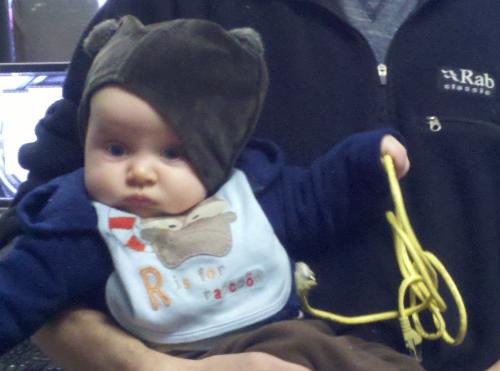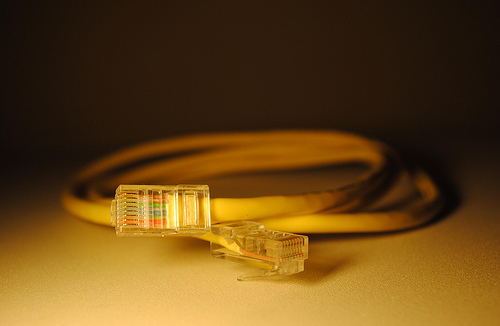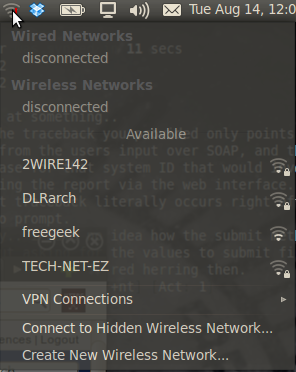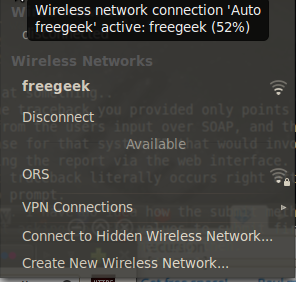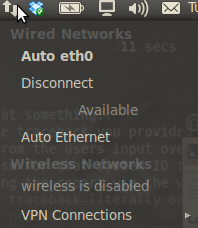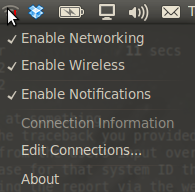How To Connect to the Internet
N.B. This page covers how to connect to the Internet via Wireless or a wired connection. For instance if you are trying to connect to a wireless access point at a coffee shop or the library, or if you have a home broadband or DSL connection (typically from Comcast or CenturyLink in Portland). It does not cover connecting via a dial up modem or via 3G (e.g. via Clear).
Wired Vs Wireless
Your broadband connection to the Internet will typically be a wired connection either connected via a phone line (DSL) or via a cable also used for TV. Unless you are only going to hook up a single computer you are unlikely to plug into it directly so you will need to set up some of home network. These come into two basic flavours wired and wireless (a.k.a wifi). It is also possible to combine the two.
Laptops from Free Geek come with a wireless card already installed, Desktops do not. If you have broadband at home your broadband provider will typically have given you a wireless router. These are also often available in the Free Geek Thrift Store at low cost. If you have a desktop you have a choice of installing a wireless card or using a wired (ethernet) connection (wireless routers also allow you to connect to them via an ethernet cable as well).
Wired connections are cheaper (wireless cards cost from $15 up + the cost of the router while an ethernet cable can be brought from the Thrift Store for $2), faster, secure and very reliable -- for this reason they are typically favored by businesses. Wireless connections, on the other hand, allow you to eliminate unsightly cables, hook up computers in other parts of your house, easily, and allow a greater range of devices to connect to the network (e.g. smart phones and tablets). On the downside they can be slower and less reliable: interference from other wireless routers, wall or floors between the computer and the wireless router, even the leaves on trees in the wrong season can all cause problems. In general, though, the convenience outweighs the potential downsides for typical home users.
If you want to put a wireless card in your desktop you need to be aware that some models work much better than others and some won't work at all with Linux. You should contact [Tech support] for advice before buying one (staff in the Thrift Store will also be able to ensure you get one that is compatible with Linux). |
Before You Start
If you have broadband at home you need to make sure it is hooked up correctly. You need to make sure the cable modem (or set top box) is connected to the wall socket and that the modem is connected to the router via an ethernet cable plugged into the hole marked 'Internet' or 'WAN' . These should have been supplied with your broadband kit. Ethernet cables have a plug on the end that looks a little like a phone plug, only bigger, and they look like this:
er, this:
Image by HelloImNik, licensed under a Creative Commons license. .
They come in a variety of colors but yellow seems very popular with broadband providers.
When you are setting a broadband connection up its best to do it via a wired connection first before trying to connect to it wirelessly.
How to Connect Via Wireless
On the top panel of your computer you should see the network symbol. Before it is connected to a network it looks like this:
If you left click on it it should show a menu like this:
This should show a list of wireless networks you can connect to, if none are showing up, or it says wireless disconnected please see the Troubleshooting section below. (I have fancy transparency effects turned on if you are wondering what is showing in the background).
Here there are four networks. You should note that all the networks apart from Free Geek have padlock symbols next to them. This means that they have encryption turned on -- you will need a password to connect to an encrypted network. The numbers of bars lit up tells you the strength of the wireless signal. To join a network just left click on its name. You should see the lit up bars on the icon on the top panel move up and down for a while. If you need a password a box should pop up, at this point, so you can enter this. If all goes well the bars will stop moving and the symbol will have changed into this:
You might also get a notification message pop up telling you have made the connection. You can check by moving your mouse over the network icon: a bubble will pop up showing you details of the connection.
If you left click on the icon you will see that the network has moved places in the menu.
At this point you should be connected to the Internet (or at least the wireless network). If you are in the library or a coffee shop etc you might first need to connect to a special page accepting their terms and conditions before you can connect to the Internet proper. You should not have to do anything special to get there. Normally you don't have to do anything special to get there. Just go to a web page as normal and you will be automatically diverted.
If you still can't get on the Internet, or you can't connect to the wireless network, at this point, see Troubleshooting below.
How to Connect Via Ethernet (wired connections)
Setting up a wired (ethernet) connection is generally very simple. Just plug one end into your computer and one end into the router (or socket) as appropriate. If you are in a library, or similar, you will often find sockets built into desk/table tops or attached to the wall. Typically the network connection will set itself up automatically, otherwise you can use a similar procedure to connecting wirelessly.
Image: tompagenet released under a creative commons license.
Picture showing the ethernet socket on a laptop. It is the socket on the right. Note the symbol above it and the two led lights built in (Most, but not all, ethernet sockets have these built in).The connection on the left is the modem. An Ethernet socket is also referred to as a NIC or network card.
Troubleshooting
If you have a laptop and it says 'Wireless is disabled'
Right click on the network icon
and make sure the 'Enable Networking' and 'Enable Wireless' entries have a check mark next to them. Left click on then to enable .
If this does not work check for a wireless switch. This varies from laptop to laptop, some times it is an actual switch, at other times a key combination you have to press (function (Fn) and one of the F keys e.g. F5) and sometimes a switch that looks like a light. They typically have some sort of symbol to identify them but this also varies from manufacture to manufacturer unfortunately.
If you are on broadband
If you are on broadband and you can't get through to the Internet (but you can connect to the wireless) do the following.
- Turn off or pull the power cord from the modem and wait thirty seconds before powering it back on.
- Pause for thirty seconds or until the lights on the front change into a steady pattern.
- Do the same to the router and wait for another thirty seconds.
- Reboot your computer.
This solves most problems with broadband regardless of the cause.
If your wireless connection is unreliable
This can have a number of causes. Sometimes it is caused by interference as a result of too many people using the same wireless channel. Most people use the default channel so setting your router to use a different channel will some times help [1]. You can install a tool called 'Wifi Radar' that will show networks are broadcasting on what channel (you will find it under the Internet menu of Applications).
Other times it is because the computer is too far from the router or there are too many walls and such like in between the two. This is difficult to deal with except by moving the computer closer. If this is not possible you can also buy a specialist antenna and connect it to the router (you can also get another antenna for the computer). These boost the signal either because of their size, superior design and/or because they send the signal in a narrower direction (called directional or sectional antenna's these can make a lot of difference). Unfortunately these are not cheap, though they can make a dramatic difference. It is possible to make your own if you are handy with a soldering iron (do a search for 'cantenna'). You might also be able to use a range booster which rebroadcasts the signal. You should contact Tech support for advice before spending a lot of money.
If none of the above work contact Tech support : it's best if you do so by phone while you are sitting in front of your computer in the place where you are trying to connect.
[1]How to do this will be different for each model of router. You should check your routers manual or help pages for more info. Typically you need to connect to a special webpage with your browser. You will need a user name or password. This is often written down on the underside of the router. If not try connecting to 192.168.1.1 or 192.168.0.1 in your browser. The default username is usually admin and the default password one of admin, password, 1234 or just leaving it blank. It's a good to change this to something more secure. You should also consider setting up an encrypted network with WPA if you haven't done so. (Some people like to leave theirs unencrypted (also known as 'open') to allow their neighbors etc to share it. If you want to share your connection you might also want to think about making it encrypted and giving out a password to people you want to share it with).
